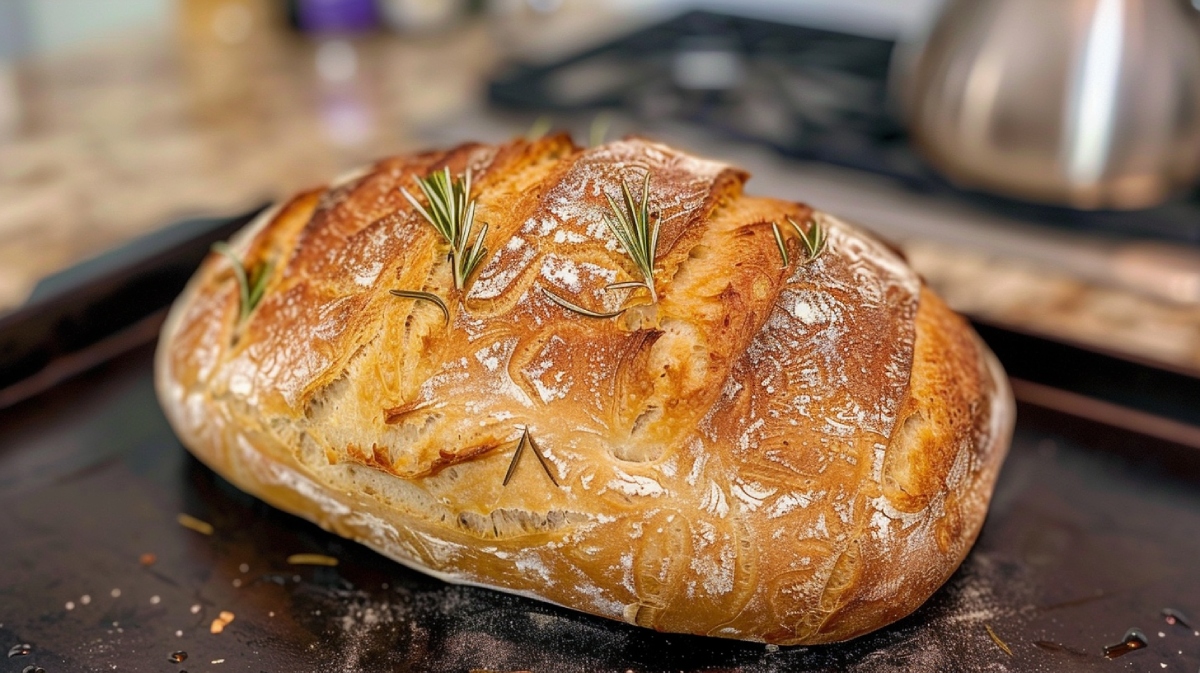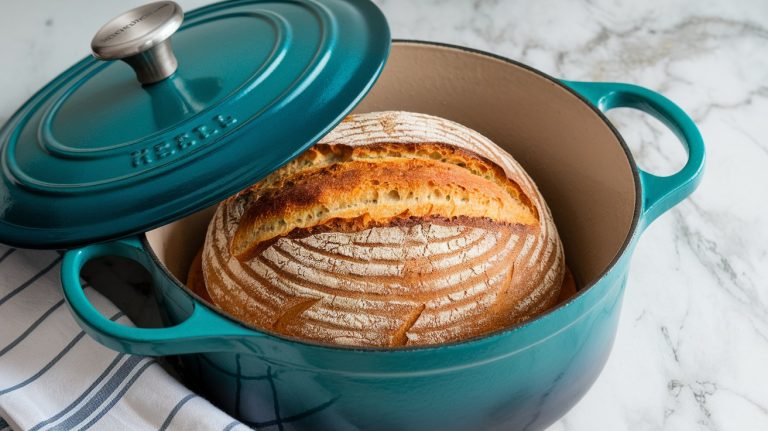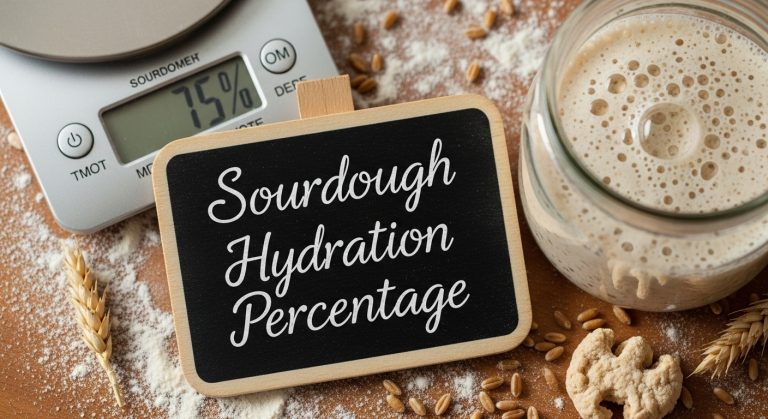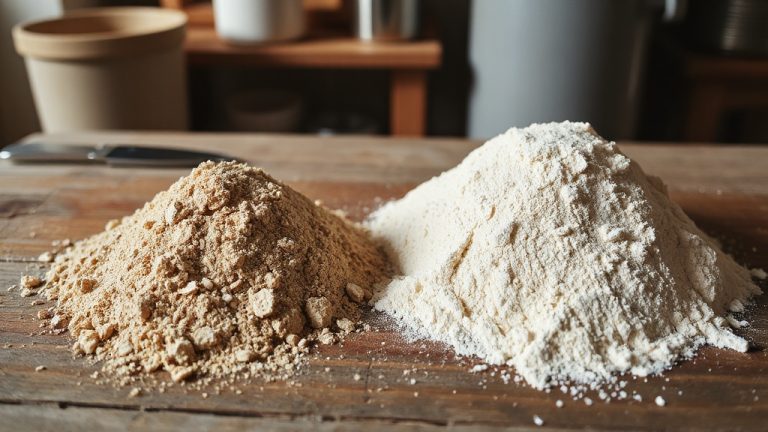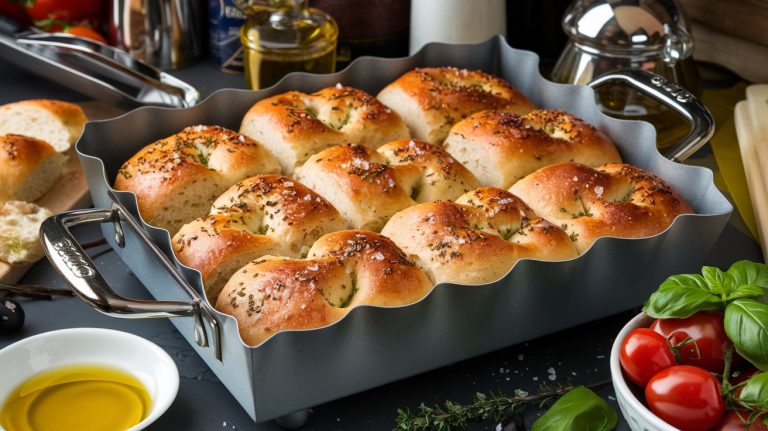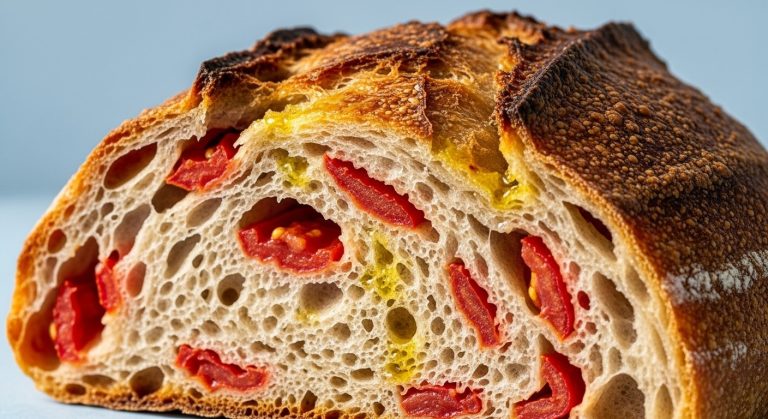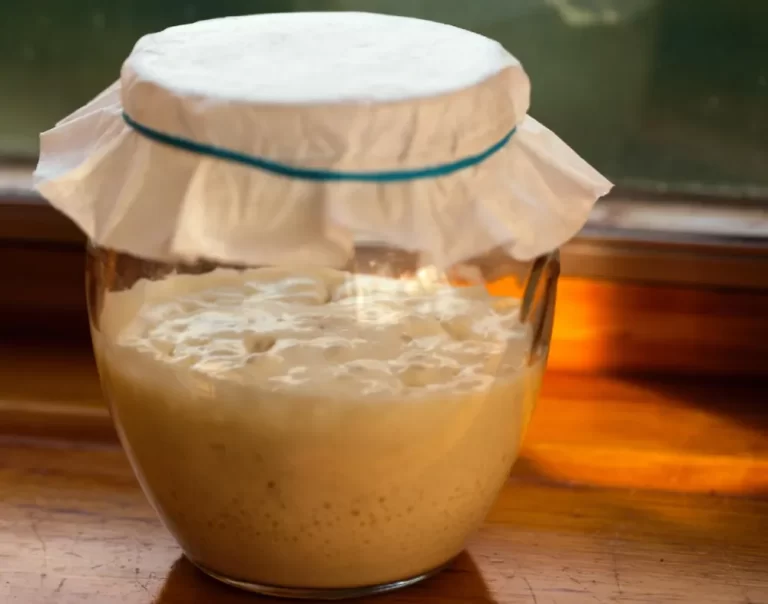How to Make Rosemary Sourdough Bread: A Simple Recipe
To make rosemary sourdough bread, start by ensuring your sourdough starter is active. Mix warm water, flour, sea salt, and finely chopped fresh rosemary.
Let the dough rest for 30 minutes, then allow it to rise warmly until doubled, roughly 4–6 hours. Preheat your Dutch oven to 500°F. Shape your risen dough, score it for steam escape, and bake it covered for 20 minutes before uncovering it and reducing the heat.
Once baked, cool it completely on a wire rack to achieve the perfect crust. There’s so much more to explore about this delightful recipe.
Key Takeaways
- Use a combination of flours like bread, whole wheat, and rye for unique textures and flavors in your rosemary sourdough bread.
- Ensure your sourdough starter is active and bubbly before mixing with warm water and flour.
- Incorporate finely chopped fresh rosemary for robust flavor and aromatic qualities in the dough.
- Allow the dough to ferment in a warm space until it doubles in size, typically taking 4-6 hours.
Why You Will Love This Recipe?
You’ll adore this rosemary sourdough bread for its robust flavor, effortless no-knead method, and the delightful aroma that fills your kitchen as it bakes.
The fresh rosemary enhances the flavor profile, making every bite a delicious experience. With the no-knead method, you can easily manage the dough using stretch and folds, eliminating the need for special equipment.
Each slice boasts a crusty exterior that gives way to a chewy interior, creating a satisfying texture you can’t resist. Plus, this bread is a nutritious option, containing only 149 calories per serving.
Its versatility shines through. It complements everything from sandwiches to side dishes, elevating your meals with its aromatic qualities.
What do You Need?
To create the perfect rosemary sourdough bread, you’ll need to focus on a few essential ingredients that bring it to life.
Each type of flour plays a unique role in the dough’s texture and flavor, while fresh rosemary adds that aromatic touch you crave.
Remember hydration; it’s key to achieving a beautifully airy crumb and a crust that’s just right.
Key Flavor Components
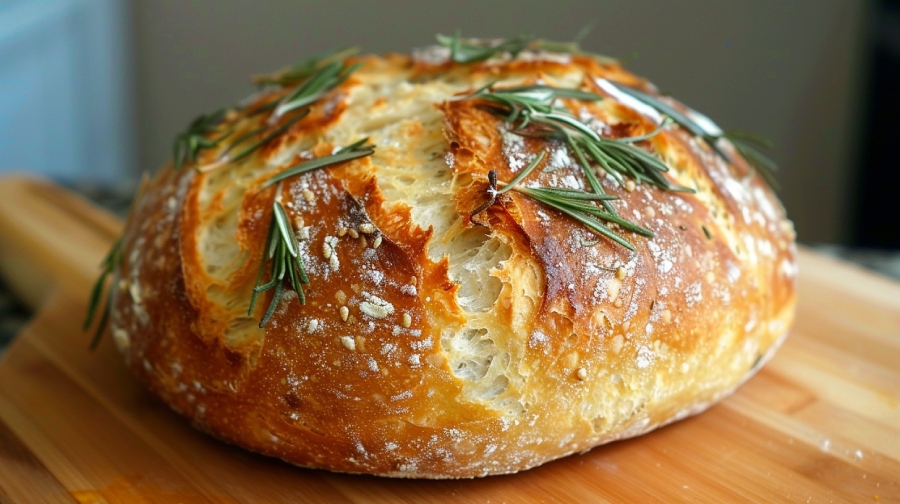
When finely chopped and incorporated into the dough, fresh rosemary consistently elevates the flavor profile of rosemary sourdough bread, creating a vibrant and aromatic experience that complements the tanginess of the sourdough starter.
To achieve that perfect blend, consider these key flavor components:
- Fresh Rosemary: Adds robust, aromatic qualities to the bread.
- Sourdough Starter: Acts as the primary leavening agent, enhancing the fermentation process and tangy flavor.
- Whole Wheat Flour: Provides nutty notes and boosts the nutritional value with added fiber.
With a drizzle of olive oil for moisture, you’ll create a loaf that’s delicious and rich in flavor and nutrition.
Flour Types Explained
Choosing the right flour is essential for crafting the perfect rosemary sourdough bread, as each type brings its own unique characteristics and benefits to the dough.
Bread flour’s high protein content activates gluten development, resulting in a chewy texture that enhances sourdough.
Whole wheat flour adds delightful nutty flavors while boosting nutritional value, especially when freshly milled.
Unbleached all-purpose flour serves as a versatile base, balancing protein without the strict requirements of bread flour.
You can also experiment with rye or spelt flour, which contributes to unique tastes and textures—rye often amplifies sourness.
Importance of Hydration
Proper hydration in sourdough bread is the key to achieving that sought-after moist, open crumb and a delightful texture that keeps you coming back for more. Aiming for a 70-80% hydration level guarantees peak gluten development and crumb structure.
Here’s why hydration matters:
- Warm water (78-80°F) activates your sourdough starter, enhancing fermentation.
- Fresh rosemary may require slight adjustments to maintain ideal consistency.
- Insufficient hydration leads to a dense loaf with a poor crumb structure.
Tools You May Need
Gathering the right tools is crucial for crafting delicious rosemary sourdough bread, ensuring each step of the process goes smoothly.
You’ll need a large bowl to mix ingredients and allow the dough to ferment.
A kitchen scale is essential for accurately measuring flour and water, ensuring the perfect consistency of your sourdough loaf.
For baking with sourdough, a Dutch oven creates a steamy environment that yields a crusty exterior and chewy interior.
Don’t forget a sharp knife or lame for scoring the dough, facilitating steam release and ideal expansion.
While a banneton is optional, it can be handy for proofing dough, helping you achieve a better shape and texture.
Preparation Steps
To kick off your rosemary sourdough bread journey, you’ll want to gather and prepare your ingredients meticulously.
Mixing the dough is where the magic begins, so pay attention to techniques that enhance flavor and texture.
Each step lays the foundation for that perfect crust and aromatic loaf you’re aiming for.
Ingredient Preparation Essentials
Start by ensuring your sourdough starter is active and bubbly. Ideally, it should be fed 4-12 hours before to kick off the fermentation process effectively. This sets the stage for a successful bake.
Gather your ingredients and measure them accurately to maintain consistency in your dough. You’ll want to use:
- Unbleached all-purpose flour for texture
- Whole wheat flour for added nutrition
- Fresh rosemary, finely chopped for that aromatic touch
Prepare a warm place for your dough to rise, allowing the active starter to work its magic.
With everything ready, you’re on your way to creating a delicious rosemary sourdough bread!
Dough Mixing Techniques
Mixing the dough with your ingredients prepped and ready is the next exciting step in creating your flavorful rosemary sourdough bread.
Start by combining your active sourdough starter, warm filtered water, and a blend of flour and water in a large bowl until a thick mass forms. Allow the dough to rest for 30 minutes, activating enzymes and promoting gluten development.
Next, fold in sea salt and finely chopped rosemary, ensuring the rosemary flavor is evenly distributed.
During bulk fermentation, use the stretch and fold technique, performing 3-4 rounds every 15-30 minutes. This enhances dough strength without traditional kneading.
Adjust the hydration for a sticky consistency, allowing air pockets to develop and creating that perfect loaf.
Baking Process
Preheating your Dutch oven to 500°F for an hour sets the stage for a beautifully crusty rosemary sourdough bread.
Once your dough has risen and doubled in size, shape it and transfer it to a floured surface, covering it with a damp towel.
- Score the risen dough to allow steam to escape and promote expansion.
- Bake it covered for 20 minutes, trapping steam for a perfect crust.
- Reduce the oven temperature to 475°F and bake uncovered for an additional 25 minutes.
This process guarantees your rosemary sourdough bread has the perfect texture and flavor, making every bite delightful.
Storage Tips
Proper storage is key to keeping your freshly baked rosemary sourdough bread delicious and crusty.
Start by wrapping the loaf in a tea towel or placing it in a paper bag to maintain that coveted crust while preventing moisture loss.
If you want to extend the bread’s life, slice it and freeze it in an airtight container or freezer bag, adding parchment sheets between slices to prevent sticking.
When you’re ready to enjoy it again, thaw the slices at room temperature for ideal texture.
Avoid plastic bags, as they can trap moisture and create a soggy crust.
For cut loaves, an airtight container will keep the bread fresh for a few days, but for the ultimate flavor, it’s best consumed within a week.
Nutritional Information
Rosemary sourdough bread not only tantalizes your taste buds but also offers a nutritious profile that’s packed with essential nutrients. Each slice provides a satisfying balance of macronutrients, making it an excellent choice for your diet.
- Calories: 149 per slice
- Carbohydrates: 31g, providing energy
- Protein: 5g, essential for muscle repair
Additionally, you’ll find 2g of dietary fiber, promoting digestive health. The sodium content is around 325mg, while potassium sits at 64mg, vital for electrolyte balance.
Thanks to the unique fermentation process, rosemary sourdough enhances nutrient absorption, distinguishing it from standard white bread and making it a wholesome addition to your meals.
Frequently Asked Questions
Is Rosemary Sourdough Bread Healthy?
Yes, rosemary sourdough bread’s packed with nutrients, fiber, and antioxidants. Its fermentation process boosts digestion and nutrient absorption, while its lower glycemic index helps regulate blood sugar, making it a healthier choice for you.
What Is the Secret to Good Sourdough Bread?
What’s the secret to good sourdough bread? It’s all about using an active starter, perfect fermentation, and mastering shaping techniques. You’ll achieve that crispy crust and airy crumb you crave with the right temperature and steam.
Is It Cheaper to Make Your Own Sourdough Bread?
Absolutely, it’s cheaper to make your own sourdough bread! You’ll save money on ingredients and avoid markup costs. Plus, baking regularly can lead to significant annual savings compared to buying artisan loaves from stores.
What Does Vinegar Do to Sourdough Bread?
Vinegar boosts your sourdough’s flavor with a tangy twist, strengthens the gluten for a chewier texture, and acts as a natural preservative, enhancing shelf life while promoting beneficial bacteria for richer fermentation.
Sourdough with Rosemary: A Symphony of Flavor and Elegance
When you slice into that warm, crusty rosemary sourdough, the fragrant herbs intertwine with the tangy dough, creating a delightful contrast of flavors.
Each bite offers a perfect balance between rustic simplicity and gourmet elegance.
You’ve transformed humble ingredients into a loaf that’s not just bread but a centerpiece for gatherings and a warm hug on quiet evenings.
So, roll up your sleeves and embrace the art of baking; the joy of homemade goodness awaits you!

